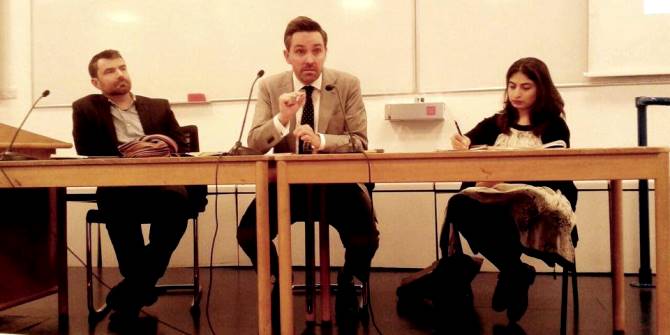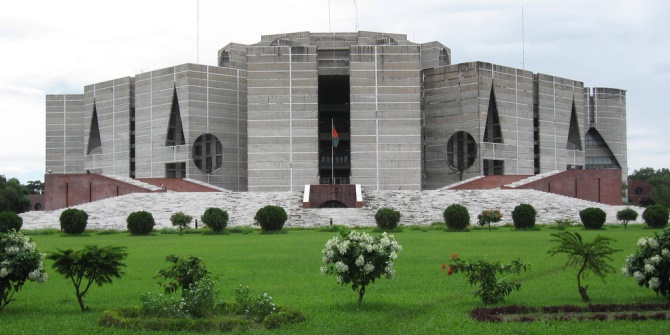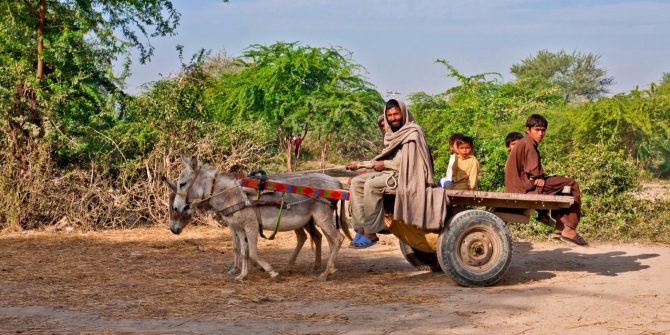 Community-based approaches to peacebuilding and an emphasis on including women’s voices in the process have given rise to models that devolve the responsibility of building peace to local women’s organisations in post-conflict situations. Drawing on her research into an initiative in Nepal, Smita Ramnarain raises questions around the model peacebuilding centred on voluntary, community-oriented work led by women and suggests how efforts can be made more sustainable.
Community-based approaches to peacebuilding and an emphasis on including women’s voices in the process have given rise to models that devolve the responsibility of building peace to local women’s organisations in post-conflict situations. Drawing on her research into an initiative in Nepal, Smita Ramnarain raises questions around the model peacebuilding centred on voluntary, community-oriented work led by women and suggests how efforts can be made more sustainable.
Ensuring women are represented in peace efforts and that local communities’ engage with post-conflict recovery are just two of the many challenges which arise when building peace in post-conflict contexts. In order to achieve genuine inclusivity, the design and implementation of peacebuilding programs that purport to include women must be unpacked further, lest they impose disparate burdens on the very women they seek to involve.
Numerous peacebuilding initiatives were financed by international organisations in the period leading up to the Constituent Assembly elections as Nepal transitioned to a democracy in 2008. One project – Ensuring the Inclusion of Women in Nepal’s Emerging Democracy (abbreviated to Developing Democracy in Nepal or DDN henceforth) – integrated peace education with women’s savings and credit cooperatives (SACCOs) in rural Nepal. This project was implemented between March 2007 and February 2009 by the Center for Microfinance (CMF) Nepal, with technical and financial assistance from Canadian Co-operatives Association (CCA) and the Canadian International Development Agency (CIDA). Since women’s SACCOs flourished during the Maoist conflict in many districts across Nepal due to their success in providing much needed credit extension services during the crisis, they provided an expedient platform to encourage women to play an active role in their communities, as educators, mediators and peacebuilders. Providing voter education, information on electoral processes in the new democracy, and human rights training to women members was considered to be a first step in facilitating women’s advocacy and participation in peacebuilding activities within their communities.
The project was deemed successful in achieving its immediate objectives of imparting awareness to women about Nepal’s political processes and stimulating local action towards violence prevention. In the short term, at least, the SACCOs were able to mobilise women’s participation in electoral and peace processes.
Engaging women in peacebuilding: two years later
A longer term objective of the program, beyond voter education and advocacy, was to mobilise women for positive social transformation and local peacebuilding. In early 2011, a research project was undertaken to look into whether the DDN had had any longer term effects in promoting peace in local communities. Documenting women’s own perspectives on peacebuilding was a crucial aspect of this follow-up research project.
Findings from this study indicated that the DDN workshops had inspired women’s conflict mediation and peacebuilding in rural communities in several ways. Motivated by the DDN, a few women’s SACCOs had carried out local campaigns against gender-based violence, alcoholism, caste and ethnic discrimination, trafficking, and environmental degradation in many places.
At the same time, however, the study cast light on some pitfalls and constraints that peacebuilding efforts by women’s SACCOs ran into. These raise larger questions around the longer term sustainability of peacebuilding, the gendered tropes it might employ, and the undue demands for voluntary, community-oriented work it may place on women.
The flipside of community-based peace work
The DDN’s narrow focus on women’s electoral inclusion, rather than broad-based social transformation meant that even as it educated women about their rights as a step in peacebuilding, it did not any undertake discussion on the context in which violence – especially violence against women – is perpetuated. An inadvertent result of selecting only women’s SACCOs for the project was that men and the broader community were seldom engaged in conversations about domestic or social violence, or the ways in which gender, caste-based, or religious discrimination and social exclusion continued in the aftermath. As one participant remarked:
For instance, we know that dowry is a bad practice, but what can we do (about it) when it is so widespread. Only if you engage the whole community will these practices stop …. But it is hard for men to listen to what women are saying.
The neglect of social context was most glaring in the assumption that by educating women, it would be possible to indirectly educate the community when women shared what they had learnt with their families. However, the household space – a space rife with gender inequality in Nepal – did not always provide women with the power or opportunity to start these discussions.
The sustainability of efforts such as the DDN also comes under question due to the top-down and funding dependent nature of many peacebuilding programs. Since the peacebuilding efforts were not built at the grassroots level, many efforts languished after initial enthusiasm waned. The project-based, target-specific nature of international aid frequently prevents longer-term, continued awareness campaigns that are required for sustained mobilisation of the community for peace. Like other limited horizon, target-based programs, the DDN, which sought to build peace without a vision for positive social transformation, eventually ran into these very roadblocks. As a result, SACCOs only had limited success in dealing with deep-rooted social practices that perpetuated violence such as trafficking, domestic violence, and caste-based or communal strife.
Significant questions also emerge around the nature of volunteer work and participation expected and elicited from SACCO members in the course of carrying out local peacebuilding activities. In interviews, women SACCO members who had participated in these activities shared stories about the ways in which ‘peace work’ – the work associated with local peacebuilding and outreach – was frequently taken up in addition to their existing market and domestic work. Over time, market and household work gained precedence for already overburdened women, negatively impacting the sustainability of peace work. As one young woman stated,
“I want to do more, but my husband and in-laws complain if I am not at home because no one is there to do the housework.”
The DDN case in Nepal thus points to how expectations of unpaid, voluntary work frequently fall upon those with the least social, political or economic resources to perform it.
The conspicuous absence of any women participants, observers, mediators or signatories in the peace negotiations in Nepal also points to an uncomfortable double standard: women are exhorted to participate in local and community-based peace efforts, but should not expect representation in the upper echelons of policy-making. As a result, women’s peace work tends to be relegated to informal spaces and small-scale local action eliding structural inequalities of power, resources, and representation in post-conflict recovery processes.
A way forward
Some lessons do emerge from this case study for local peacebuilding.
That peacebuilding should include women is crucial; however, it is also critical to consider how power relationships are driving the agenda on women’s participation, and the manner in which this participation is brought about. While community-based efforts that aim to give women a stake in post-conflict reconstruction and peacebuilding are an important step where women are virtually absent in such conversations in the public space, initiatives organising women for peace work are reminiscent of other crises situations where women’s work is increasingly depended upon for community survival.
Women are also asked to participate in community initiatives without the corresponding power to design the initiatives in question, or the means to carry them forward when the programme ends. By the same token, programmes that focus only on women may neglect the matrix of power relationships women are placed in, in their households and within society. As a result, opportunities to undertake meaningful dialogue on gender relations, values, and expectations may be foregone.
While peace work need not be paid work, initiatives that seek to engage the community must be cognisant of the responsibilities that members of the community already face, and find ways to mitigate the additional responsibilities such work might place on women. For instance, a formalisation of communal childcare, kitchens, and community spaces may be an essential step in achieving egalitarian participation by women in contexts such as Nepal. The provision of linkages that allow women to specialise as paid community mediators may be another way forward to recognise the value of such peace work.
The task facing researchers, advocates and practitioners, then, is to ensure that women’s participation and voice can be included in peacebuilding and reconstruction processes at multiple levels without exploiting pre-existing power asymmetries that impose further burdens upon them.
A link to the paper containing this case study and a more detailed discussion may be found here.
Cover image: Women participating in a community meeting. Credit: Global Action Nepal CC BY 2.0.
The views contained in this blog post are the author’s, and not necessarily those of the Canadian Cooperatives Association, the Canadian International Development Agency (CIDA), or the Center for Microfinance (CMF) Nepal. The author gratefully acknowledges the financial and logistical support provided by these organisations during the research phase for this case study.
About the Author
 Smita Ramnarain is affiliated with the Department of Economics, University of Rhode Island, USA. Her research interests include gender in development policy, post-conflict reconstruction, aid, and microfinance. Her work has been published in diverse and interdisciplinary fora such as Feminist Economics, Gender Place & Culture, the Community Development Journal, and in edited volumes.
Smita Ramnarain is affiliated with the Department of Economics, University of Rhode Island, USA. Her research interests include gender in development policy, post-conflict reconstruction, aid, and microfinance. Her work has been published in diverse and interdisciplinary fora such as Feminist Economics, Gender Place & Culture, the Community Development Journal, and in edited volumes.







